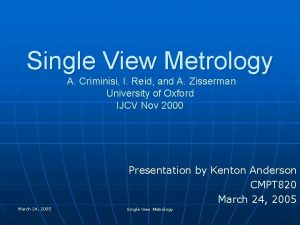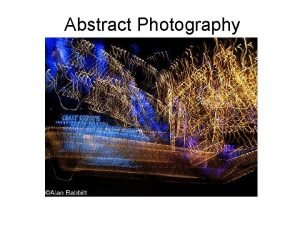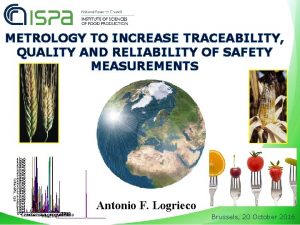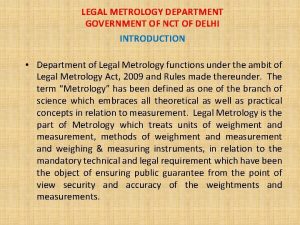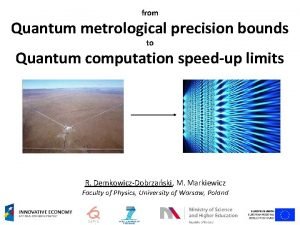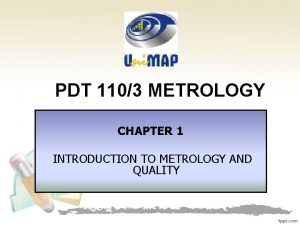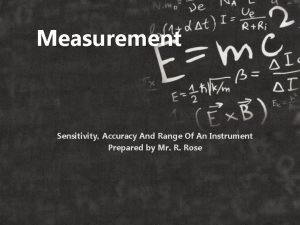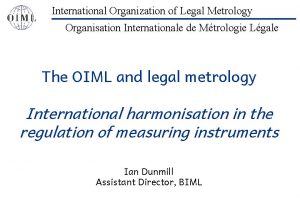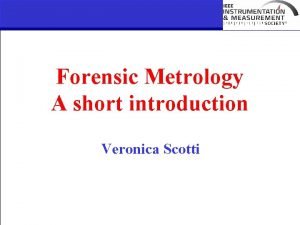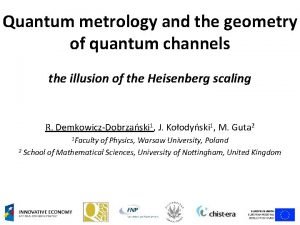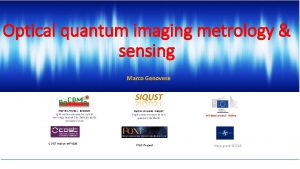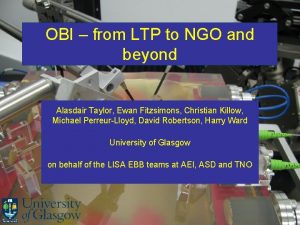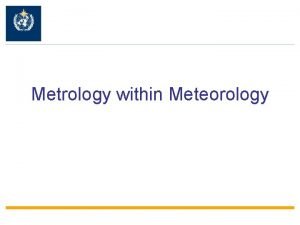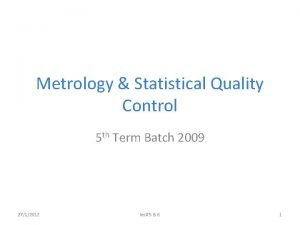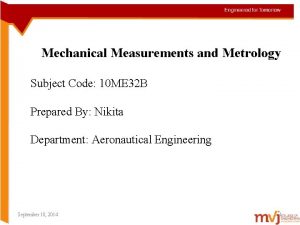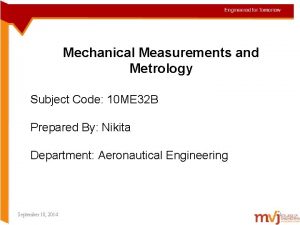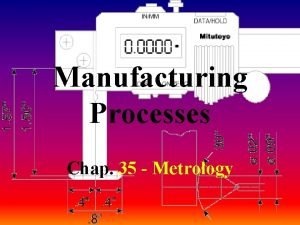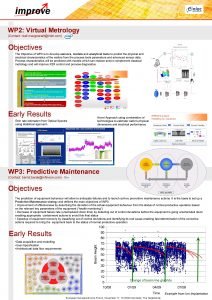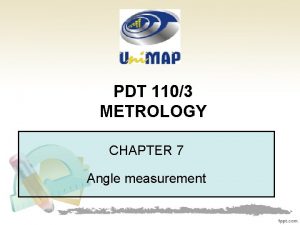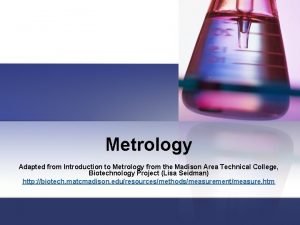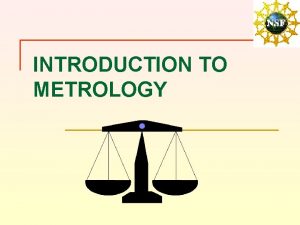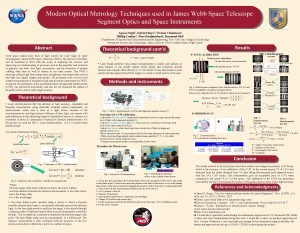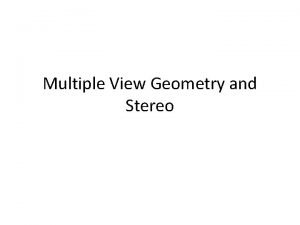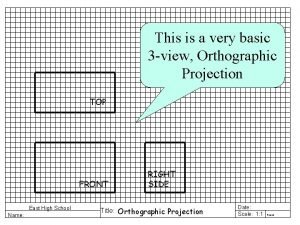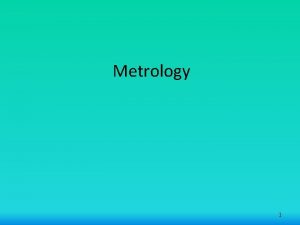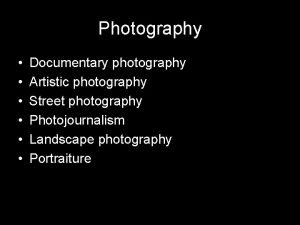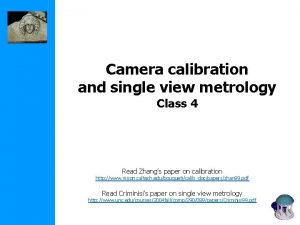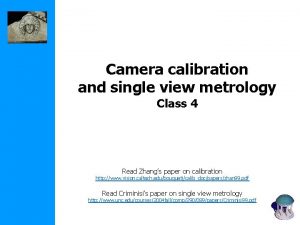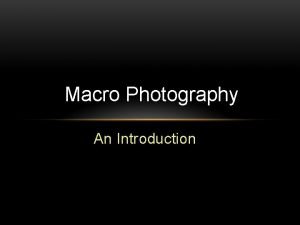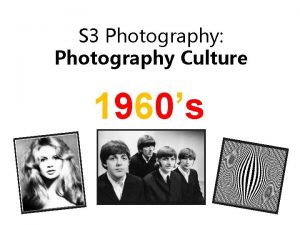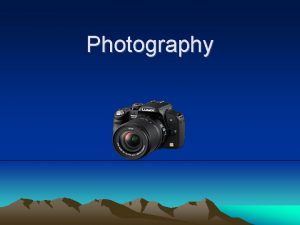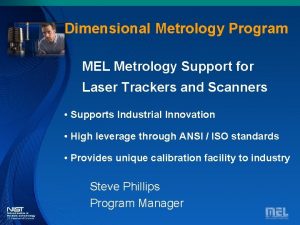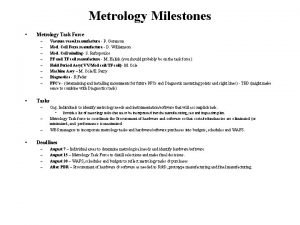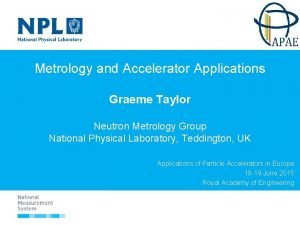Single View Metrology Class 3 3 D photography




































- Slides: 36

Single View Metrology Class 3

3 D photography course schedule (tentative) Lecture Exercise Sept 17 Introduction - Sept 24 Geometry & Camera model Camera calibration Oct. 1 Single View Metrology Measuring in images Oct. 8 Feature Tracking/matching Correspondence computation (Jan-Michael Frahm) Oct. 15 Epipolar Geometry F-matrix computation (David Gallup) Oct. 22 Shape-from-Silhouettes Visual-hull computation Oct. 29 Stereo matching Project proposals Nov. 5 Structured light and active range sensing Papers (TBD) Nov. 12 Structure from motion Papers Nov. 19 Multi-view geometry and self-calibration Papers Nov. 26 Shape-from-X Papers Dec. 3 3 D modeling and registration Papers Dec. 10 Appearance modeling and image-based rendering Papers (TBD) Dec. 17 Final project presentations

Single View Metrology

Measuring in a plane Need to compute H as well as uncertainty

Direct Linear Transformation (DLT)

• Direct Linear Transformation (DLT) Equations are linear in h • Only 2 out of 3 are linearly independent (indeed, 2 eq/pt) (only drop third row if wi’≠ 0) • Holds for any homogeneous representation, e. g. (xi’, yi’, 1)

Direct Linear Transformation (DLT) • Solving for H size A is 8 x 9 or 12 x 9, but rank 8 Trivial solution is h=09 T is not interesting 1 -D null-space yields solution of interest pick for example the one with

Direct Linear Transformation (DLT) • Over-determined solution No exact solution because of inexact measurement i. e. “noise” Find approximate solution - Additional constraint needed to avoid 0, e. g. not possible, so minimize

DLT algorithm Objective Given n≥ 4 2 D to 2 D point correspondences {xi↔xi’}, determine the 2 D homography matrix H such that xi’=Hxi Algorithm (i) For each correspondence xi ↔xi’ compute Ai. Usually only two first rows needed. (ii) Assemble n 2 x 9 matrices Ai into a single 2 nx 9 matrix A (iii) Obtain SVD of A. Solution for h is last column of V (iv) Determine H from h

Importance of normalization ~102 1 ~104 ~102 orders of magnitude difference! Monte Carlo simulation for identity computation based on 5 points (not normalized ↔ normalized)

Normalized DLT algorithm Objective Given n≥ 4 2 D to 2 D point correspondences {xi↔xi’}, determine the 2 D homography matrix H such that xi’=Hxi Algorithm (i) Normalize points (ii) Apply DLT algorithm to (iii) Denormalize solution

Geometric distance measured coordinates estimated coordinates true coordinates d(. , . ) Euclidean distance (in image) Error in one image e. g. calibration pattern Symmetric transfer error Reprojection error

Reprojection error

Statistical cost function and Maximum Likelihood Estimation • Optimal cost function related to noise model • Assume zero-mean isotropic Gaussian noise (assume outliers removed) Error in one image Maximum Likelihood Estimate

Statistical cost function and Maximum Likelihood Estimation • Optimal cost function related to noise model • Assume zero-mean isotropic Gaussian noise (assume outliers removed) Error in both images Maximum Likelihood Estimate

Gold Standard algorithm Objective Given n≥ 4 2 D to 2 D point correspondences {xi↔xi’}, determine the Maximum Likelyhood Estimation of H (this also implies computing optimal xi’=Hxi) Algorithm (i) Initialization: compute an initial estimate using normalized DLT or RANSAC (ii) Geometric minimization of reprojection error: ● Minimize using Levenberg-Marquardt over 9 entries of h or Gold Standard error: ● compute initial estimate for optimal {xi} ● minimize cost over {H, x 1, x 2, …, xn} ● if many points, use sparse method

Uncertainty: error in one image (i) Estimate the transformation from the data (ii) Compute Jacobian , evaluated at (iii) The covariance matrix of the estimated is given by

Uncertainty: error in both images separate in homography and point parameters

Using covariance matrix in point transfer Error in one image Error in two images (if h and x independent, i. e. new points)

Example: s=1 pixel S=0. 5 cm (Criminisi’ 97)

Example: s=1 pixel S=0. 5 cm (Criminisi’ 97)

Example: (Criminisi’ 97)

Monte Carlo estimation of covariance • To be used when previous assumptions do not hold (e. g. non-flat within variance) or to complicate to compute. • Simple and general, but expensive • Generate samples according to assumed noise distribution, carry out computations, observe distribution of result

Single view measurements: 3 D scene

Background: Projective geometry of 1 D 3 DOF (2 x 2 -1) The cross ratio Invariant under projective transformations

Vanishing points • Under perspective projection points at infinity can have a finite image • The projection of 3 D parallel lines intersect at vanishing points in the image

Basic geometry

Basic geometry • Allows to relate height of point to height of camera

Homology mapping between parallel planes • Allows to transfer point from one plane to another

Single view measurements

Single view measurements

Forensic applications 190. 6± 4. 1 cm 190. 6± 2. 9 cm A. Criminisi, I. Reid, and A. Zisserman. Computing 3 D euclidean distance from a single view. Technical Report OUEL 2158/98, Dept. Eng. Science, University of Oxford, 1998.

Example courtesy of Antonio Criminisi

La Flagellazione di Cristo (1460) Galleria Nazionale delle Marche by Piero della Francesca (1416 -1492) http: //www. robots. ox. ac. uk/~vgg/projects/Single. View/

More interesting stuff • Criminisi demo http: //www. robots. ox. ac. uk/~vgg/presentations/ spie 98/criminis/index. html • work by Derek Hoiem on learning single view 3 D structure and apps http: //www. cs. cmu. edu/~dhoiem/ • similar work by Ashutosh Saxena on learning single view depth http: //ai. stanford. edu/~asaxena/learningdepth/

Next class • Feature tracking and matching
 Single view metrology
Single view metrology Is abstract photography same as conceptual photography
Is abstract photography same as conceptual photography Saudi standards, metrology and quality organization
Saudi standards, metrology and quality organization Toshiba 1b japanasia
Toshiba 1b japanasia Reliability in metrology
Reliability in metrology Legal metrology delhi
Legal metrology delhi International metrology organization headquarters
International metrology organization headquarters Metrology
Metrology Introduction to metrology
Introduction to metrology Pakistan meteorological department founded
Pakistan meteorological department founded Define sensitivity in metrology
Define sensitivity in metrology International metrology organization headquarters
International metrology organization headquarters Forensic metrology
Forensic metrology Software metrics and software metrology
Software metrics and software metrology Metrology
Metrology Metrology
Metrology Ebbing metrology
Ebbing metrology Bipm metrology
Bipm metrology Interchangeability definition in metrology
Interchangeability definition in metrology Metrology and measurements subject code
Metrology and measurements subject code Metrology and measurements subject code
Metrology and measurements subject code Emirates authority for standardization and metrology
Emirates authority for standardization and metrology Define allowance in metrology
Define allowance in metrology The limit fit
The limit fit Virtual metrology
Virtual metrology Sine table in metrology
Sine table in metrology What is metrology
What is metrology Introduction to metrology
Introduction to metrology Optical metrology techniques
Optical metrology techniques Senamet
Senamet Sisd in computer architecture
Sisd in computer architecture Dataxin
Dataxin Waiting line management system
Waiting line management system Single view geometry
Single view geometry Single view geometry
Single view geometry Single view of the citizen
Single view of the citizen The orthographic view drawn directly above the front view
The orthographic view drawn directly above the front view
